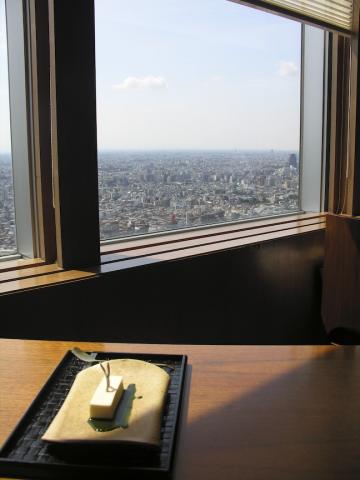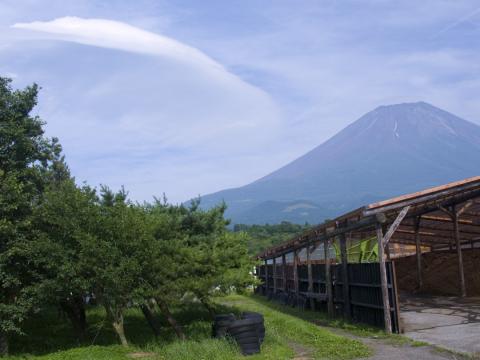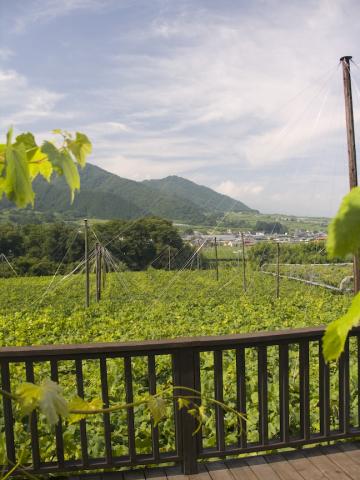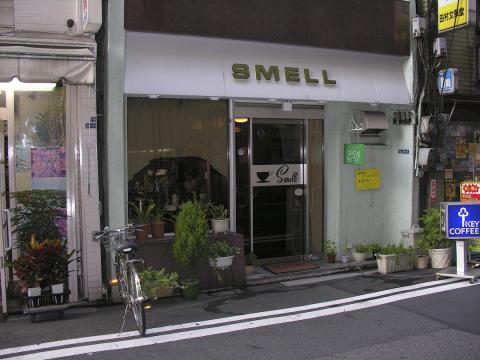Vintage Point - wine in Japan
POSTED ON 15/03/2008Sitting in the lofty Peak Lounge of the Park Hyatt where Bill Murray and Scarlett Johannson cosy up in Sophia Coppola’s Lost in Translation, you can just about make out the distant pyramid of Mount Fuji beyond the panorama of Tokyo’s skyline. From one spectacular peak to another a couple of hours drive away, I found myself standing at the foot of the sacred volcano itself, in a vineyard planted with tender shoots of the native koshu grape. I was in Tokyo as a judge at the Japan Wine Challenge, a competition organized by wine merchant Ronald Brown aimed at rewarding the best wines on the Japanese market. It was an unmissable opportunity to find out with my own eyes, nose and palate to what extent a beer and sake-suffused culture is absorbing wine, not least its own home-grown product.
 view from the Park Hyatt
view from the Park Hyatt
If turning such hallowed ground to wine seems odd at first sight, the koshu project is an idea that resonates with the Japanese. Ernie Singer, an American wine merchant whose brainchild it is, has been given the go-ahead by the government to plant not just a vineyard but to build a winery within a stone’s throw of Japan’s highest mountain. The Mount Fuji vineyard in Fuji-Hakone-Izu National Park is just one of 12 experimental vineyards planted throughout Japan by Mr. Singer, who’s lived in Japan since he was a boy and now runs a wine importing company, Millésimes. He has a burning conviction that koshu is the future for Japanese wine. To that end he’s not only convinced the government of its worth but teamed up with the renowned Bordeaux wine professor, Denis Dubourdieu, to make a koshu wine at the Grace Winery in Katsunuma.
I was aware before arriving in Tokyo that affluence and aspiration had give the Japanese a thirst for wine, much of it French. I had little idea of the extent of its popularity. The Japanese drink three to four bottles wine per person a year. Not a lot – as yet. According to Kevin Whelehan, whose company Pieroth supplies some 7,000 Tokyo restaurants, ‘fine wine is the latest fashion accessory and the Japanese are not short of a yen or two’. The boom is evident in the huge numbers of Japanese sommeliers (more than any country outside Italy) and the 191 star-rated restaurants in the first Michelin restaurant guide to Tokyo published in November. London, by comparison, has 50, Paris 98. First stop then the ultra-sophisticated Michel Troisgros at the Century Hyatt, which was awarded two stars for stylish dishes such as thinly sliced scallops with basil and truffle oil and filleted John Dory in bonito jelly, set off by a classic French wine list. The Troisgros beret is also doffed to a Japanese section including a 2005 Grace Winery Cuvée Misawa Koshu Toriibira Vineyard.
What of koshu on Japan’s dining table? According to Ernie Singer, what little wine consumption there was in Japan until the mid-1980s was either domestic rotgut (97 per cent of Japan’s domestic product is imported or made from imported grape concentrate) or cheap and sickly German wine. Five years ago, Grace Winery’s owner, Shigekazu Misawa, came to see him to ask if there was a future in exporting Japanese wine. Singer gave some wine made from koshu to Denis Dubourdieu and Robert Parker, the American wine guru. They gave it the thumbs down. Mr.Misawa came back with 100 cases of a purer, fruitier style he’d developed. Robert Parker liked it and scored it 87 – 88 out of 100. Dubourdieu was happier with it too and decided to get involved. That, claims Ernie Singer, was a major factor in kick-starting Japan’s blossoming new affair with koshu.
 Fuji blows its top
Fuji blows its top
Before teaming up with Mr. Singer, I’d been on the same judging panel at the Japan Wine Challenge as Fumiko Arissaka, who buys the wines for Japan Airlines. She gave me the lowdown on koshu and Japan’s suitability for producing wine. ‘It’s a bit like riesling’, she pointed out. ‘It’s fresh and light and can come in a range of styles ranging from dry to sweet. The problem is that Japanese conditions are tough for wine grapes. First we have monsoon weather in July rain and wind and rain at harvest. Secondly our soils are acidic and overfertile. Thirdly it’s a very vigorous variety and finally the growing season is relatively short’. Starting to wonder why anyone bothered. I was reassured by a handful of refreshingly fragrant and palatable examples in the small koshu section of the competition. The best were from Katsunuma in Yamanashi north-west of Tokyo.
Fumiko hadn’t mentioned yet another problem: space for vineyards in a mountainous, densely populated, rice-growing country. On the way to Katsunuma, an hour out of the concrete jungle of Tokyo, the train suddenly popped out into a pretty-as-a-picture, almost Tuscan landscape of densely forested, steep hills towering above small villages connected by winding roads and meandering rivers crossed by bridges. Two-storey village houses with wide windows and balconies, pantiled roofs and tidy gardens displayed a neatness echoing Alsace or South Tyrol. Rice paddies become pocket handkerchief-sized here, so the competition for breathing space between wine grapes, table grapes and rice is self-evident. My wife Charmaine and I got off the train at the village of Enzan, from whose narrow main street you catch glimpses of vineyards climbing the slopes of tree-clad hills.
A short taxi ride brought us to a small winery, Rubaiyat Marufuji, where the translator had even fewer words of English than the owner, Haruo Omura. We headed straight for the tiny, terraced vineyards bordered by drystone granite blocks hewn from local stone. Koshu here has to compete for breathing space with eating grapes of sumo proportions: Pione, Adirondack and Fujiminori. Each bunch is painstakingly umbrella-wrapped with a square of waxy greaseproof paper to keep the monster grapes safe from rain and birds for their eventual resting place along with perfect cherries, peaches and square (yes square!) watermelons, on the shelves of upmarket Japanese department stores like Takashimaya and Daimaru.
 Katsunuma vineyards
Katsunuma vineyards
Unlike European vines which are largely trained on wire trellises, koshu is grown on a high pergola, allowing the bunches to hang down for air circulation. With only around 150 vines to the hectare (compared to 4,000 or more in France), the vines are Jack-and-the-beanstalk in nature, basically small trees, only with canopies spreadeagled instead of reaching to the heavens. Tongue half in cheek, Mr. Omura tells us that the height of the pergola is set ‘according to the height of the owner’. We crouch awkwardly beneath the canopy while the owner strolls beneath it head held high.
It’s a short hop from here to Katsunuma Jozo, which supplies JAL business class with a dry white koshu. Overlooking the hazy Katsunuma hills, the winery’s Le Restaurant dans La Vigne is kitted out in dark wood with an impressive, cathedral-vaulted ceiling. It’s a favourite watering hole for customers from the Kanto plain area and Tokyo itself. A crisply refreshing 2005 Aruga Branca Clareza washed down sea bream sushi with radish, onion and cabbage sprout accompanied by a clear radish, carrot and corn consommé. Like a claret / pinot noir cross, a 2004 Merlot chimed nicely with wafer-thin slices of medium rare marbled Koshu beef (which gorges itself on a whisky mash and wine) seasoned with horseradish, soy and wasabi (the sweet, hot fresh version as distinct from the one-dimensional, exported toothpaste tube variety).
Through Isabel Cuevas, a visitor on a Spanish wine producers training programme, the engaging owner, Yuji Aruga, explained that the pink-skinned koshu is synonymous with Japanese culture and tradition. The descendant of vines carried along the Silk Road to Japan in 718 AD, it was a favourite of the Shogun during the Edo period (1603 - 1868). As Japan opened up to West, two ex-samurai, Ryuken Tsuchiya and Masanari Takano, were sent to Bordeaux in 1877 to study winemaking. Their efforts on their return kick-started the Japanese wine industry, although until recently, koshu was considered no better than cheap and cheerful plonk. ‘The Japanese don’t yet appreciate the value of Japanese wines so they automatically think that foreign wines are better, said Mr.Aruga. ‘The image of foreign wines is very good, especially French wines, but sommeliers have helped to promote Japanese wines, so koshu is growing in popularity’.
For dinner that evening at Suzuki-en Ryokan, a traditional Japanese inn, we were poured Thumbelina-sized glasses of an indifferent Japanese wine from an old-fashioned 1.8 litre bottle. Corked! My disappointed body language was met with an incomprehendingly blank stare. The eventual replacement thimbleful of an equally anodyne off-dry white failed to do justice to the thinly sliced cured ham on onion and daikon, panfried flatfish with haricot beans and chunky, teriyaki pork ribs. I pointed beseechingly at a sake bottle. The sake came in a large water tumbler, so we didn’t mind so much when we both inevitably thumped our heads on the huge cross-beam in our stifling hot, attic bedroom.
The following day in Katsunuma we visited Grace Winery, arguably Japan’s best exponent of koshu. Founded in 1923, Grace is owned by the intense, scholarly Mr.Shigekazu Misawa. The old winery is spotless inside, so much so that you have to take your shoes off before entering and don white wellies (I first thought it was to avoid getting our feet wet). Grace includes the tiny, west-facing Toriibira vineyard, said to be the oldest vineyard in Yamanashi. At first sight, the vineyards here resemble a green carpet, but you soon see that it’s the top of a canopy adapted by Mr. Misawa to a long cordon to reduce vigour and yield. A perfectionist, Mr. Misawa believes that wineries need to adopt more natural winemaking practices to bring out koshu’s potential. It’s an effect he achieves with his single vineyard wines, notably the elegantly dry, chablis-like Cuvée Misawa Koshu Toriibira Vineyard, which is on the list at Michel Troigros.
 mmm....savour the aromas
mmm....savour the aromas
The rustic charms of Suzuki-en, we discovered, failed to do justice to the traditional ryokan. At Nanjyo Ryokan that evening in the charming, spa village of Bessho Onsen, the superior facilities included a fabulously smelly and relaxing 24-hour hot sulphur bath. From a reception area containing a number of stuffed animals, we were shown to a typical room with tatami mats, low table and paper sliding doors. Having googled spa bath etiquette, we knew we had to take off clothes and rinse in segregated ‘his and hers’ spas, then shower before returning for the full rotten egg-smelling monty. Duly refreshed, we were ushered to our own private dining room where a low table was spread with a feast fit for an imperial retinue. It was hard to know where to begin but a welcoming glass of junmai sake helped. A smiley woman with no English kept re-appearing with a series of amazing dishes, 33 in all.
If Yamanashi is Japan’s little Napa Valley, Nagano, higher and further north in central Honshu, is an emerging quality region for wine grapes thanks to its altitude. Surrounded by the 3000 metre high Japanese Alps, ‘the roof of Japan’ is a scenic province of wooded highlands, waterfalls and lakes with sprawling conurbations fanning up hillsides from river valleys. Manns here, owned by Kikkoman, is geared for tourism with a western-style restaurant, pretty gardens and a showcase plot of vines grown in Japan. Its winemaker, Dai Shimazaki, is making fine burgundian style chardonnay, the Solaris Shinshu, and a juicy merlot in the St.Emilion mould, Solaris Shinshu Komoro. His claim that their work started on koshu in the early 1990s is borne out by a 1993 Solaris ‘Kosyu’ Koshu, a characterful sweet white kept under nitrogen for 10 years to preserve its delicately honeyed, citrusy fruitiness and refreshingly tangy aftertaste.
850 metres in the hills, the Villa d’Est Garden Farm and Winery is, in contrast, a small lifestyle project with an Italian accent: Villa for Italian country house, Est from the Italian wine Est! Est!! Est!!! It’s the brainchild of Toyoo Tamamura, a talented watercolourist and food writer, who moved here from Tokyo in 1991 and was inspired by the fabulous views to plant merlot and chardonnay, then build a winery. ‘I like wine and spent several years in France as a student so I got used to having a wine every day but never thought I would start a winery’, says Mr.Tamamura. ‘Five years ago, people who ran restaurants didn’t know about Japanese wines. Today the image of Japanese wine as a cheap import is changing as more people are making an increasingly authentic product’. At the terraced restaurant overlooking the valley, we sipped his crisp, pineappley 2005 Villa d’Est Reserve Chardonnay and a cherryish, merlot-based 2005 Villa d’Est Vignerons Reserve.
Below the cloud line at 1000 metres in the Matsumoto hills, we were greeted that evening at the de luxe Myojin-kan Ryokan by a young Japanese woman. She showed us to our room, poured tea and explained the bath ritual. Our three room suite consisted of an antechamber and large bathroom wet room, separated by a silk screen from an elegant bedroom with roomy, marshmallow-soft beds, and by another screen to a cosy sitting room. A huge window opened to the hillside just 50-odd feet away with a brook babbling busily below. After a luxurious stone bath hot spa, again we drank sake, a fragrantly fresh junmai ginjo, with a series of beautifully presented dishes served by an elegantly kimono-clad woman. Shellfish to start, then soup of hojiso flower with shiitake mushroom and chunky marinated daikon (radish), grilled aiyu on smoky dried tea, salmon in houba leaf, eel and shrimp sushi, delicately flavoured thin strips of beef, and so on. Uncertain at various stages what ‘that gloopy stuff’, ‘that chewy white ball’ or ‘that blobby thing’ was, we surrendered to the procession of colours, textures and flavours.
Back in Tokyo we met up with Ernie Singer and his daughter Amy, who were keen to show off the koshu wines they make at Manns’ other winery in Katsunuma. ‘Japan is the only country in the world with a culture of fresh fish preparation’, Mr. Singer pointed out. ‘No-one has yet made a wine specifically designed to go with Japanese cuisine. By striving for purity of fruit, there are flavour components that are unique to Japanese cuisine’. On my travels, I had already found that as a crisp, delicate dry white, the best of koshu is good company for most of the specimens you find among the mind-boggling array of pulsatingly fresh seafood at Tokyo’s bustling Tsukiji fish market. Crisp, light dry whites are clearly made for sashimi and sushi, especially river eel (unagi), sea eel (anago), pike conger eel (hamo), sea urchin, sweet shrimp, fat belly tuna and flatfish. Blowfish (fugu) ovaries and the warty, sausage shaped sea cucumber, mind you, need a stronger stomach than mine, with or without wine, sake, beer or shochu.
We ate at RyuGin in Tokyo’s Roppongi district, a modern Japanese restaurant with two Michelin stars, where the young chef, Seiji Yamamato, knows the Fat Duck’s Heston Blumenthal well. Cue a gastronomic sense of humour in dishes such as pea corn ‘wine’, in actual fact a soup poured from a ‘claret’ bottle labelled 1970 Chateau RyuGin (opened with a flourish by the sommelier) and fruit salad with liquid nitrogen blowing ‘steam’ out of the hollow glass handle. The clean, tart 2006 Koshu Denis Dubourdieu cut nicely through a grilled snapper and tofu croquette complete with flossy lime foam (in the Japanese tradition of fish printing, the image of the fish is silk screened in squid ink onto a white marble plate). A pinot grigio-like 2006 Kenkoji Koshu enlivened sashimi of fat belly tuna, sweet shrimp and flatfish with a variety of seasonings: plum sauce, yuzu powder, shrimp salt and a sting of wasabi.
Can Ernie Singer succeed in his self-appointed mission to adapt koshu to Japan’s unique and difficult growing conditions? ‘It’s true that conditions are tough, but vines acclimatize and technological progress has brought Japan within the ambit of what’s possible’, he said. Having arrived wondering if the Japanese had got beyond the stage of giving wine as a gift, I was surprised at the extent to which wine is being assimilated into the culture. Quality koshu itself is still in its infancy, but progress in the vineyard combined with a growing pride and willingness to give it a try suggests that it’s on its way. As Ernie Singer says, ‘What sells wine is its uniqueness and koshu is unique. There’s really no reason why it can’t be viable in Japan’. Thanks to a dedicated bunch of Japanese wine producers, koshu is gradually being brought within the ambit of the possible.
Info Box
Getting There
Anthony Rose travelled with Japan Airlines. JAL offers a direct daily service to Tokyo and Osaka, and an extensive domestic network within Japan. Online fares are available from £540 Economy Class, £961 Premium Economy and £3205 Business Class (inclusive of taxes and charges) and are applicable to Tokyo, Osaka and other destinations in Japan. Visit www.uk.jal.com or call 0845-7747-700 for further details.
Eating There
Michel Troisgros: Century Hyatt, Tokyo. www.centuryhyatt.co.jp.
Le Restaurant dans La Vigne: www.katsunuma-winery.com
Villa d’Est Garden Farm and Winery: www.villadest.com
RyuGin: 7-17-24 Roppongi, Minato-ku, Tokyo 10600032. 03-3423-8006.
Staying There
Suzuki-en, Katsunuma: 5,700 yen (£25) per person including breakfast and dinner. Website in Japanese only. T: +81 (0)553-44-0319
Nanjyo Ryokan, Nagano: doubles from 8,000 yen (£35) per person including breakfast and dinner www.nanjyoryokan.com
Myojin-kan Ryokan, Matsumoto: doubles from 32,550 yen (£143) per person including breakfast and dinner. www.tobira-group.com/emyojinkan/
Park Hyatt Tokyo: doubles 55,700 yen (£242). www.tokyo.park.hyatt.com.
For further travel information details, contact JNTO at www.jnto.com.

